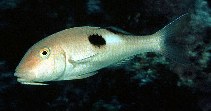| Family: |
Mullidae (Goatfishes) |
| Max. size: |
33 cm TL (male/unsexed); max.weight: 906.0 g |
| Environment: |
reef-associated; marine; depth range 1 - 120 m |
| Distribution: |
Indo-Pacific: East Africa to Hawaii and the Line, Marquesas and Tuamoto islands, north to the Ryukyu Islands, south to Lord Howe and Rapa islands. |
| Diagnosis: |
Dorsal spines (total): 8-8; Dorsal soft rays (total): 9-9; Anal spines: 1-1; Anal soft rays: 7-7; Vertebrae: 24-24. Diagnosis: Pectoral rays 16 (rarely 15 or 17). Gill rakers 6-8 + 21-25 (total 28-32). Body depth 3.45-3.95 in SL; head length (HL) 2.85-3.1 in SL; dorsal profile of snout straight to slightly convex, the snout length 1.7-2.05 in HL; barbel length 1.3-1.55 in HL; longest dorsal spine 1.4-1.7 in HL; last dorsal soft ray of adults longer than penultimate ray, the latter contained 1.1-1.25 in length of the former; posterior margin of caudal-fin lobes straight to slightly convex; pectoral-fin length 1.3-1.5 in HL; pelvic-fin length 1.25-1.45 in HL. Body pinkish to yellowish gray, the scale edges narrowly dark, with a black spot about 3-4 scales in width on lateral line below posterior part of first dorsal fin, followed by a large pale pink to white spot; a blue spot often present on each scale above lateral line, always present posteriorly; pale blue spots, one per scale, ventrally on body, but often not visible; short blue lines radiating from eye except ventrally; barbels pale pink to white; basal third of second dorsal fin with a broad black or blackish band or a large black spot, sometimes extending onto adjacent back, the outer part of fin with narrow blue and yellow bands; anal fin with faint pale blue and yellow bands; remaining fins varying from yellowish gray to light red (Ref. 54393). |
| Biology: |
Primarily an insular species (Ref. 30573). Usually solitary, it occurs in seagrass beds (Ref. 41878) as well as over sand, rubble, or coral and rock bottoms of shallow lagoon and seaward reefs to a depth of at least 46 m (Ref. 30874). Benthopelagic (Ref. 58302). Feeds on benthic animals like crabs, polychaetes and other worms during the day (Ref. 30874), also shrimps, heart urchins, gastropods, pelecypods, foraminiferans, brittle stars, and fishes (Ref. 37816). |
| IUCN Red List Status: |
Least Concern (LC); Date assessed: 11 March 2015 Ref. (130435)
|
| Threat to humans: |
harmless |
Source and more info: www.fishbase.org. For personal, classroom, and other internal use only. Not for publication.

